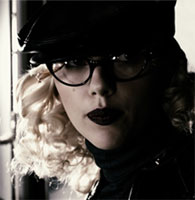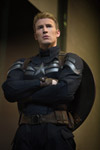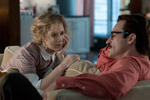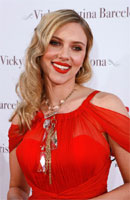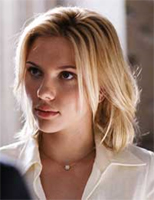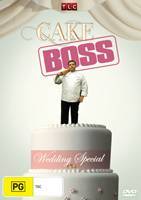Scarlett Johansson Under The Skin
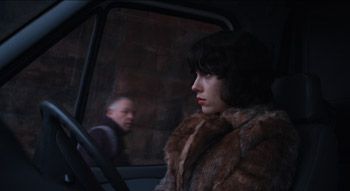
Scarlett Johansson Under The Skin
Cast: Scarlett Johansson, Jeremy McWilliams, Lynsey Taylor Mackay
Director: Jonathan Glazer
Genre: Drama, Sci-Fi, Thriller
Rated: R
Running Time: 108 minutes
Synopsis: Under The Skin is the story of an alien in human form. Part road movie, part science fiction, part real, it's a film about seeing our world through alien eyes.
Under The Skin
Release Date: May 29th, 2014
About The Production
Into the Unknown: The Making Of Under The Skin From Book to Script
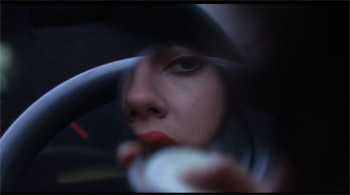 In the space of 12 years and three feature films, Jonathan Glazer has established himself as a director of style and innovation. His debut, Sexy Beast, invigorated the British gangster movie by infusing a tense London heist story with dark shades of Jacobean tragedy, a feat achieved largely by the unexpected and inspired casting of Sir Ben Kingsley as the film's sociopathic villain. The follow-up, Birth, took similar liberties, this time with the ghost story, starring Nicole Kidman as a woman who believes her late husband has been reincarnated as young boy. So it is perhaps significant that Under the Skin, which began development even before Birth, is another reinvention of genre.
In the space of 12 years and three feature films, Jonathan Glazer has established himself as a director of style and innovation. His debut, Sexy Beast, invigorated the British gangster movie by infusing a tense London heist story with dark shades of Jacobean tragedy, a feat achieved largely by the unexpected and inspired casting of Sir Ben Kingsley as the film's sociopathic villain. The follow-up, Birth, took similar liberties, this time with the ghost story, starring Nicole Kidman as a woman who believes her late husband has been reincarnated as young boy. So it is perhaps significant that Under the Skin, which began development even before Birth, is another reinvention of genre.
Producer James Wilson read the book and was immediately smitten. 'I was taken with the central conceit of that character," he recalls, 'that this alien, in the form of a female human, is on Earth to catch people. In the novel, the idea is that we are the food source for this alien species, and I thought it was a really compelling story idea – a really cinematic idea, one that lent itself to cinematic interpretation because it was about senses and sensations, both visual and auditory."
He continues, 'I was working at Film4 at the time as an executive. We optioned the book, and I remember thinking that it might be something an innovative director might be drawn to, because it would allow them to push the envelope, in terms of film language. Shortly after that we sent it to Jonathan, who was making Sexy Beast with us at the time. Jonathan Glazer's reaction was the same as mine. My memory is that he was very quickly drawn to the strength of the central concept, and what that meant for him was seeing the world through alien eyes – effectively re-seeing the world."
Jonathan Glazer immediately signed up for the task, but it would be a while before he would find a way to bring it to the screen.
Working with a series of writers, Jonathan Glazer began to interrogate the possibilities of the story, until a collaboration with Walter Campbell, a colleague from the advertising world, provided the breakthrough he was looking for. 'Walter Campbell had never read the book," says Jonathan Glazer, 'so it was really good to have a completely new point of view.
'We left the book behind a long time ago," he continues. 'There is definitely the residue of the narrative from the book, but now it's expressed in different ways. Even so, I can see the element that was the spark for me, which was this idea of re-seeing the world through those eyes. That was the North Star, for me. But I don't think anything specific was retained, at least nothing obvious. There's nothing illustrative from the book, although there may well be ideas or themes, or re-workings of atmospheres."
Explains James Wilson: 'The book explores a lot of other things. It explores the idea of what would it be like if we were a source of food for somebody else? It's almost a vegetarian horror story, in that it's a metaphor for industrialised food practices and factory farming. The men in the novel are captured, held underground, fattened up, castrated, have their tongues cut out and processed. But Jonathan Glazer was less interested in dramatising that. He was more interested in the idea of the main character's point of view, of -re-seeing' our world, and ourselves, through the eyes of another – almost like the process we go through when we watch a nature documentary about animals."
The result was that Jonathan Glazer decided to play bold with the novel's twist, revealing the girl's extraterrestrial origins right at the beginning. Wilson admits that this decision to was not immediately embraced. 'I remember thinking, -Why would you do that?' he says. 'But it was Jonathan Glazer's idea to make it a virtue – to say, -Let's tell the audience right away that she's synthetic, that's she's not real, and that will inform everything we see from that point on.' Because you'll know you're looking at the world from the point of view of…" He laughs. 'Well, you might not know quite what it is, but it's certainly something that's not human."
Adds Jonathan Glazer, 'The book relied on a twist, which is very effective in a book, but in a film it only works once. I didn't think people would return to the film and enjoy it again if we were relying on a twist in the same way. So it felt obvious that we should be upfront about it. So then you can sit back and enjoy her perspective, knowing that you're looking at the world through alien eyes."
Casting Scarlett Johansson
At the inception of the film, Jonathan Glazer was firm about a single point. 'My thing was, I never wanted to cast it with famous people," he recalls. 'I wanted a barmaid from the Holloway Road! I didn't want to have a movie star. And I was really conflicted about that, for obvious reasons." Nevertheless, Jonathan Glazer agreed to consider Scarlett Johansson, initially when the film was looking to be a more faithful rendition of Michel Faber's novel. Says Scarlett Johansson, 'Jonathan Glazer and I had been talking about this project for three years before shooting, and it went through many incarnations during that time. Originally, the script was kind of a two-hander; it was about a couple posing as man and wife. The community was more involved, so it was like a witch hunt, in a way."
As the script developed, they kept in touch. Jonathan Glazer recalls, 'I was meeting up with Scarlett Johansson every now and then. We didn't even talk about it when we first met. We must have met three or four times over quite a few years." All this time, the intention was to make a broader, more expansive film. But after making the decision to make the film smaller and more intimate, Jonathan Glazer began to see Scarlett Johansson in a different light. Says James Wilson, 'When we realised we needed to reduce the expense of this film so we could make it the way we wanted to make it – to be free, creatively – it became obvious that the actress needed to be someone we could mount a film on."
For Jonathan Glazer, Scarlett Johansson was the best of both worlds. 'I understand the need to cast somebody who means something in the marketplace – it's the law of the jungle, isn't it? But while you're making a film, you don't want to be aware of any of that. I certainly don't want to make a film with half an eye on the box office. I'm not interested in that, I'm interested in fulfilling a journey, an idea, and it soon became clear that she was the best candidate for the role. She had a real appetite to do something risky, and she threw herself into it. This is not the Scarlett Johansson as you might see her in a glossy magazine – this is an actress who's fully committed."
Now that the film's story had been pared down to a single character, Scarlett Johansson began to focus on the challenge. 'What originally drew me to the project," she says, 'was this idea of putting on another skin and completely transforming into someone almost unrecognisable – but without being completely unrecognisable. I found that to be endlessly intriguing. And eventually this story evolved into what it is now, which is a story that really only follows one protagonist – it's a -she' but it's really an -it'. Then there's the transformation, as Jonathan would say, from an -it' to a -she', and that's what I think the film, at its core, is really about."
With Scarlett Johansson on board, Jonathan Glazer began to see extra opportunities. 'My interest was very much involved with the idea of disguise," he says. 'To be honest, the casting process became much more interesting to me when that idea landed – to put a Hollywood star in disguise and drop them into the real world, not onto a movie set. And not let t
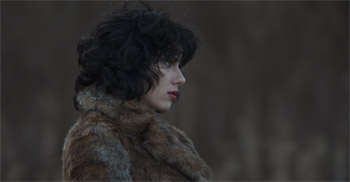 he real world know we were there." He adds, 'The incongruity of Scarlett Johansson in Glasgow – you're already in alien territory. That's beautiful fuel for that conceit. I wasn't making casting decisions just to get my film made, I was making casting decisions because they were the right casting decisions."
he real world know we were there." He adds, 'The incongruity of Scarlett Johansson in Glasgow – you're already in alien territory. That's beautiful fuel for that conceit. I wasn't making casting decisions just to get my film made, I was making casting decisions because they were the right casting decisions."Says Scarlett Johansson, 'It's very rare to come across an opportunity like this to play a character who goes through the kind of transformation that Laura does. The transition she makes is like that of a butterfly – she starts off as this kind of amoeba, part of a mass, and she's cocooned. Then suddenly she transforms into this colourful creature, who is experiencing all these new and different things. It's such a beautiful, poetic story, and it's incredibly touching to me."
Creating The Girl
The complex process of writing and casting is reflected in the film's psychedelic opening sequence: an eye being formed in the infinite darkness of space. 'Originally, you would see her whole body being made," says Jonathan Glazer. 'But I realised that we didn't need all that. The alien eye was the core of it. If we were only going to hit one note with that image, then that was it."
As the eye is being created, we hear the sounds of the girl talking, making vowel sounds and repeating simple, everyday words. This says, Jonathan Glazer was 'a happy accident", which he was inspired to include after hearing Scarlett Johansson doing vocal training with dialect coach Paula Jack in order to perfect her character's English accent. Recalls James Wilson: 'Jonathan Glazer saw her warming up, doing these voice exercises. It wasn't part of the original idea, but he thought it was interesting."
Says Jonathan Glazer: 'It's the equivalent of this alien getting ready to descend into our world. She's being prepped for that. It came from something Walter and I had talked about a long time ago, and we had actually written entire scenes of her preparations. It's the alien version of getting ready to go to Earth," he continues. 'First the body is made, and then these are the exercises."
Once the girl is created, we see her taking a body from the side of the road and dressing herself in the dead woman's clothes. 'The first girl is her predecessor," explains Jonathan Glazer. 'She's the girl doing the job that Scarlett's character will be doing. She's come to an end, so we join her journey at the end of it. Then Scarlett goes on the same journey, and the cycle repeats."
The girl is aided in her journey by helmeted men on motorbikes. We never see their faces or hear them speak. 'They needed to be invisible," says Jonathan Glazer. 'They needed to look like they were normal human beings, going about their business, and you see a lot of people on motorbikes in Scotland. But they're really just representative of the alien mission, whatever that may be. They're this kind of unwavering line through the film: they just do what they do. They don't have the same experience she has; they're not as close to human beings in the world as she is. So they remain unwaveringly alien, and by keeping that true throughout the film, it helps us to read her drift away from that. They remind us of the baseline."
This opening set-up is achieved with very little in the way of traditional exposition. Says Jonathan Glazer, 'There was certainly more about them in the shooting script, and we did film some more scenes containing information about who they were and what they were doing. But I began to feel that if the construction of the film was too conventional you would step out of the experience. And what really made sense to me in the edit was that we had to commit to that position of watching the film through the girl's eyes. The film itself needed to be an alien experience – you needed to feel that you weren't being given all the information, in the same way she hasn't been given all the information. You had to be alongside her throughout. You needed to be inside the story, with her."
Similarly, though the character in Michel Faber's novel was called Isserley, and was briefly christened Laura for the purposes of shooting, there are no character names listed at the end of the movie. 'We never gave the characters actual names," says James Wilson. 'They were named after what they did functionally, so we had The Lonely Man, The Nervous Man, The Bad Man and so on." Adds Jonathan Glazer: 'The idea is that your experience of these people is also the girl's experience of these people. Which is why they're nameless – their individuation is not important."
Indeed, the question of how the aliens would communicate was a thorny issue throughout the film's long gestation period. Asks James Wilson: 'How do you tell a story through exposition when you've got a character that isn't human? How are they going to express things in a way that will allow the audience to know what's going on? For example, would the aliens speak English? In an early incarnation of the script there was another alien character with her on earth, and they spoke to each other – the idea being that it helped you learn what they were doing. But that raised the question: would they speak to each other in English when there was no one else around? Those conventions are often utilised in science fiction, but when we tried it, it just didn't seem to have the rigour of the kind of film that we were trying to make.
'It seemed a bit Star Trek – aliens speaking to each other in English," he continues. 'Why would they do that? So we tried another convention, which was to try to create a language of our own. There were versions of the script where the aliens spoke English words that were slightly transmogrified in syntax and grammar, a Clockwork Orange kind of thing. But, again, it just seemed a bit contrived, and we came to the decision that they wouldn't use human language other than to go about their business. They go undercover in our world in a way that a spy or a cop would."
The Tiger on the Prowl
Reducing the scale of the movie was one thing, but how would the filmmakers create the necessary levels of real-world truth and subjectivity that Jonathan Glazer was looking for? This was a question that producer James Wilson acknowledged as soon as the film's aesthetic began to emerge. 'If you're looking at our world through alien eyes," he says, 'we have to see an unfabricated world. It can't be a world made by the paraphernalia of filmmaking – extras, constructed sets – we have to be looking at our world. So that meant putting Scarlett Johansson in our world as her character. Working back from that creative idea, we had to construct a technical methodology of how to do that."
After many debates, it was decided that Scarlett Johansson would be filmed using miniature cameras, interacting with genuine, non-acting strangers wherever possible. Says James Wilson: 'Jonathan Glazer always had a dream of driving around in a van with Scarlett, seeing if she could get a real person to get in. I'll admit now that I never thought this would work. If you could drive around for a week, yes, but this was a low-budget, independent feature film, and we didn't have the luxury of driving around for a week just to get one happy accident. But Jonathan Glazer stuck to his guns."
Shooting in the van was one of the biggest technical problems facing the team. Explains James Wilson, 'The conventional way to shoot driving scenes is by having a rig on the front of the vehicle that you mount the camera onto, or you tow the car on a loader, so its wheels aren't actually on the road. But we couldn't do it that way. You can't be incognito on the streets of Glasgow if there's a camera stuck on the front. So we had to work backwards from our ethos and think, OK, so how do we do this? The answer was to put cameras in the car – but they had to be hidden."
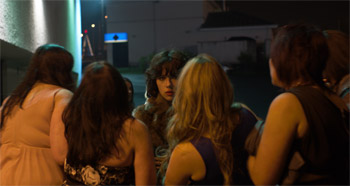 Technical supervisor Louis Mustill takes up the story. 'The first challenge was Jonathan Glazer's desire to film in a very natural way," he says, 'and part of that meant not having the baggage of a normal movie set. You don't want 70 people, big cameras, huge lights – all that stuff – getting in the way of the story. So the question was: How do you fit enough cinema-quality cameras in a small space in a way that doesn't ruin the scenario and make the actors behave in a completely unnatural way? We looked at just about everything that was available – from things that were off the shelf, all the way up to cutting edge of very small high-quality cameras – and we couldn't really find anything. So we started to consider coming up with some technology of our own. It wasn't a question of building it from scratch, however, it was more a matter of taking technology from outside the film world and repackaging it, making it usable to a traditional film crew."
Technical supervisor Louis Mustill takes up the story. 'The first challenge was Jonathan Glazer's desire to film in a very natural way," he says, 'and part of that meant not having the baggage of a normal movie set. You don't want 70 people, big cameras, huge lights – all that stuff – getting in the way of the story. So the question was: How do you fit enough cinema-quality cameras in a small space in a way that doesn't ruin the scenario and make the actors behave in a completely unnatural way? We looked at just about everything that was available – from things that were off the shelf, all the way up to cutting edge of very small high-quality cameras – and we couldn't really find anything. So we started to consider coming up with some technology of our own. It wasn't a question of building it from scratch, however, it was more a matter of taking technology from outside the film world and repackaging it, making it usable to a traditional film crew."Says Jonathan Glazer, 'There were eight cameras built into the dashboard, behind headrests, places where you would normally find an air conditioner, and so on. They were all wired into the back, behind the bulkhead. Behind the bulkhead I'd be sitting in a chair and I'd have a monitor with eight images on it from the eight camera feeds. I'd have the DP sitting next to me, two guys doing Digital Imaging, the First AD and the sound man. Behind us, there'd be a follow-up van, with makeup people and PAs, who had to jump out of the van and get release forms from people that we happened to film. It was very exciting to have the actor, the main character of the film, right at the head of the arrow point, forging the story out, just by virtue of turning left or right."
Scarlett Johansson admits that this took a little while to get used to. 'I went into this project with absolutely no idea how we were going to shoot it or what it was going to be," she says. 'It was weeks before I even knew what I was doing. Jonathan Glazer and I spent a lot of time talking about it, both of us saying, -I will not let you down – I will give you everything I have!' I don't think either of us knew quite what we were doing. But we started it, and it became clearer as we went along."
To James Wilson, Jonathan Glazer acquitted herself admirably. 'I remember listening from the other van, he recalls, 'and the challenging thing for her was that she would have to start off each conversation with a simple request for directions. She would say, -I'm lost,' or, -I need to find the post office.' But then, for the purpose of the moment we were going for creatively and narratively, she had to bend the conversation towards the notion of a pick-up. We used to call it -The Tiger on the Prowl'. She's hunting, and so she's finding out if the person is a suitable victim. Are they alone? Will they be missed? So she would have to go from, -I need to find the post office,' to, -Do you live alone?' or -Are you busy right now?' or -Are you going to work?' It was a strange kind of verbal gymnastics."
For Scarlett Johansson, it was a challenge worth facing. 'I can't say I know what a normal film is," she says. 'Nothing ever feels normal, even if you're making some huge action film for a studio. But this one was certainly an experience I'd never really had before, partly because there was the covert side of it. When you're working that way, you just have to be open to anything, and because of that you really do allow yourself to be vulnerable. Which is terrifying but it's also very thrilling at the same time. I certainly discovered a lot about myself and my limits, what makes me self-conscious. I became incredibly self-conscious, because I was suddenly totally aware that I had this secret that nobody else knew about. But once you get over that, it's beautiful, because things happen in an organic way that could never happen if they were scripted."
Says Jonathan Glazer, 'We made sure the cameras were built into the van in such a way that they wouldn't be seen – not only by the people who got in the van, or the people she spoke to, but also by Scarlett Johansson herself. Normally an actor is going to be very aware of where the camera is, and because Scarlett Johansson didn't actually know, she was completely immersed in the function of driving, looking and hunting. She was in the real world. For me, that was the apex of the whole experience, this invisibility that we had, which enabled us to just watch the story unfold – write itself, somehow."
Watching from the sidelines, James Wilson noticed some surprising results. 'Something that was quite interesting," he says, 'is that whenever she bent the conversation towards a more forward line of enquiry, one that had some kind of sexual undertone to it, many of them shrank away. When faced with a female presence that was assertive, they were terrified; they just wilted in its presence. You might think, going in, that they would think, -Wow, it's Christmas!' but that wasn't the case. It was an interesting snapshot of male psychology when faced with an assertive female presence."
After each encounter, the production team would have to secure the relevant permissions from each of Scarlett Johansson's unsuspecting pick-ups. Says James Wilson: 'The permissions aspect was actually very simple. After the scene, an Assistant Director would jump out of the van, run up to them and explain what was going on – that we were making a film, they were being filmed at that time, and would they would sign a release form for it? Of course, if they didn't sign it, we couldn't use the scene. But everyone we approached did sign it, and the results were extraordinary. It reminds me of the greatest nature documentaries – you feel you are seeing something that actually happened, that hasn't been manipulated, hasn't been fabricated, staged or choreographed. We were striving for authenticity, and I think you can see it in a simple sequence like the scene at the beginning, in which she walks through the shopping centre to find the clothes she will wear for the rest of the film."
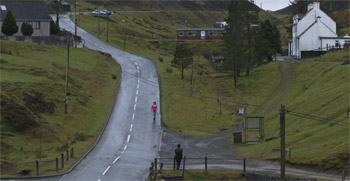 Another key sequence is one in which the girl goes to a nightclub to hunt for prey. The production hired the venue for two nights, setting up hidden cameras in key positions as well as using tiny roving cameras so that Scarlett Johansson could move freely within the club. Says James Wilson, 'We retired to a little back room, the club opened, people flooded in and we waited for it to get really full. Scarlett Johansson slipped out at about midnight and moved around the club, and we would do take after take after take. You can see in the film that some guys are clocking her, watching her as she walks through the club. Which works in the fiction, because the character is supposed to be alluring and charismatic, so the idea of men's eyes being drawn to her works really well with the character."
Another key sequence is one in which the girl goes to a nightclub to hunt for prey. The production hired the venue for two nights, setting up hidden cameras in key positions as well as using tiny roving cameras so that Scarlett Johansson could move freely within the club. Says James Wilson, 'We retired to a little back room, the club opened, people flooded in and we waited for it to get really full. Scarlett Johansson slipped out at about midnight and moved around the club, and we would do take after take after take. You can see in the film that some guys are clocking her, watching her as she walks through the club. Which works in the fiction, because the character is supposed to be alluring and charismatic, so the idea of men's eyes being drawn to her works really well with the character."The Black Room
Whenever the girl picks up a human male, she takes him back to a house, where the victims are expecting to have sex. In Michel Faber's novel, the holding area was a familiar, if primitive, variation on battery farming, with multiple victims packed into low, underground pens. But when Jonathan Glazer came to approach those scenes he realised, once again, that less would be more. 'I wanted to feel the horror," he explains.
Instead of a cage, the girl's victims find themselves in another dimension, in a darkness that engulfs them. 'One minute they're in the street, then they're in this black space above the floor, then in this black space below the floor," says Jonathan Glazer. 'There's a different sound, a different light, a different atmosphere, then all their innards are sucked from the skin and everything else discarded. The trophy, the treasure, is what's inside – the skin to the aliens is just a plastic bag."
'That room was interesting to me," he continues, 'because it became about what that space implied – this alternate dimension. That's the horror of it, I think. The whys and the wherefores of that are not interesting to me. I wanted it to be something you would have to intuit. I didn't want it to be literal. I wanted to feel lost in that space. I didn't want to have any barometer, any compass, or to feel like I knew where I was. I wanted to be in an alien space. And so we ended up creating a kind of dreamscape for that, because the furthest we can get away from our reality is in dream space.
'Now, I enjoy films that show me the hardware of alien life – spaceships and so on – I really do," he says. 'But it just didn't feel to me that this film would benefit from being so direct in that way. I wasn't trying to be opaque. It was very much about having the ambiguity of the alien in this film. I didn't want to show the nuts and bolts of it. I wanted it to feel right, rather than get caught up in the technology of it. It was the blackness that inspired me – it felt to me like that's where they're from. They are made manifest through that blackness, whatever they are."
Nevertheless, the ethos that infused the shooting of the real world in Jonathan Glazer's movie also carried over into these more fantastical scenes. Says James Wilson, 'The design principle, ironically enough, was the same as the above-ground, documentary-reality principle. Obviously, we were creating a completely artificial world. But Jonathan didn't want it to be done with computer graphics. He wanted it to be filmed in a physical space that would be real for the performers."
Says Jonathan Glazer: 'You can do it more cheaply and more easily with computer graphics, but it won't have a soul. It's just zeroes and ones. By actually filming it, you understand it as being real. I wanted to take those men and give them a physical experience, then shoot that physical experience. Again, it's something that adds to the viewing experience. You feel it."
The scenes were shot in the studio, with the actors walking on black glass in a black space, while the sinking effect was achieved using a pit filled with a black liquid. 'To the naked eye," says James Wilson, 'it looks like a continuous surface. As they stepped off into it, there was a hydraulic platform submerged just below the surface of the black goo that lowers down." To film the scenes in which the men are submerged in the goo, Jonathan Glazer used a water tank. 'But I didn't want it to look like water," he says. 'To me, they're in this weird kind of amniotic gas." As well as removing air bubbles in post-production and using underwater lighting to avoid refraction, Glazer took some unusual steps to preserve the scene's mystery. 'Another thing that's always a giveaway sign of shooting underwater is hair," he says, 'because it will move as it does in water – because it is in water. So we gave one of the actors a wig made of his own hair, but in tungsten wire. For another, we cut his hair very short and varnished it like wood. We were trying to remove anything you would recognise. Take those things out and you're left with a very powerful experience."
The Girl's Journey, AKA the Drift
From the moment we first meet the girl, there are a series of incidents that transform her from a remorseless predator to a creature with a more advanced self-awareness. For Scarlett Johansson, it was important to establish a sense of innocence from the start. 'When we see her initially," she says, 'our immediate instinct is not to sympathise with her, because what she's doing is so horrific. She really has no empathy. But it's not because she's psychotic, she's just a different species. It's like a lion hunting a zebra. She is not driven by evil. She has absolutely no feeling about what she's doing; she has no relationship with human life at all. It's really about sustenance. It's not because she's looking to ruin a family or take someone's son, it's just a hunger she's feeding."
A scene that underlines the character's default inhumanity finds the girl walking on a beach and witnessing a dramatic scene of self-sacrifice. 'We were looking for a way to demonstrate her non-humanness," says Jonathan Glazer, 'a way to show the distance between us and them.
The girl watches all this impassively. Says Jonathan Glazer, 'What human being would do what she does? What human being would leave that child there? I don't think I've met one. Well, I hope I haven't met one. So what is she? It was really about putting that idea in front of the audience."
Soon, however, the girl's journey forces her to question her mission and even her own identity. This also posed problems for the filmmakers. Says James Wilson, 'It couldn't be a story in which there was one transformative moment where this alien became humanised. You know the kind of thing – the sterile, emotionless robot sees a child in distress and suddenly a tear falls from its eye. It couldn't be like that. It had to be a more gradual transformation, it had to seem as though all the vagaries and the strangeness, all the beauty and the ugliness in our world – the mess really of being a human being on planet Earth – had just seeped into this alien, through the cracks."
Jonathan Glazer was emphatic about this. 'The change in Scarlett Johansson's character was never something I felt should happen in a single moment," he says. 'It didn't feel like it should be an epiphany. It felt very much like it had to be a drift, and it had to be something that happened to her by osmosis. And charting that drift was a very, very complex task. When we started work on the film, people would say, -Well, how does she change? What's the moment that she changes?' And I used to say, -There isn't a moment. It doesn't happen like that.' That really became the single most difficult task in making the film – having her journey make sense, finding the rhythm of that, and making the events within it clear enough. These moments all make sense afterwards. While they're happening, you wouldn't necessarily say, -Oh, that's significant.' But, collectively, they describe a kind of drift."
An important part in this process is a scene in which the girl is walking along Trongate, a busy Glasgow street, and trips up. Again, there were hidden cameras: some in shop windows, one held by a camera operator standing nearby with a suitcase. 'It's a subtle but key moment in the gradations of her change," says James Wilson. 'She trips and falls flat on her face. You're there with her – she's face down on the pavement – and you hear human voices saying, -Are you all right, love?' -Do you want a hand?'" Then she's picked up, they dust her off and she goes along on her way.
Says Jonathan Glazer, 'It made sense to me that it would be really good if she was to fall over, to have her be strident and certain, confident – everything we've seen her be up until that point in the film – and then see her miscalculate. Like we all do, when we miss a step or hit the pavement in the wrong way and just go down. I wanted it to be as simple as that, but for it to have more significance, because of the character that she is. So we went up to shoot that scene, hid our cameras like we always did, and had her fall over. The point of the scene really was to feel that fallibility.
'I was certain that there were going to be people who would pick her up," he continues. 'I thought that was a really exciting moment, a very simple demonstration of human kindness. But it couldn't be staged, it needed to be real. I wanted to put her in a street that was busy enough that it could happen, and it did – she was picked up every time."
Amazingly, although the scene was repeated several times in various locations, few bystanders realised that a Hollywood actress was in their midst. Recalls James Wilson, 'Jonathan Glazer insisted that the scene be done for real – Scarlett had to walk down a real street in Glasgow and fall flat on her face. We couldn't have extras because it would look fake, they would look like actors. I said, -We'll never get away with it. People will recognise her, and our cover will be blown.' But we did it."
Scarlett Johansson came to realise that the incongruity of her being on a busy Glasgow street was in some ways an extra layer of the disguise. 'The truth is, if people aren't expecting you to be there, then you're not really part of their reality," she reflects. 'People in general are mostly going about their lives – they're not looking for a hidden camera crew. We're really in our own kind of world."
The end of the hidden camera section is signalled by an encounter the girl has with one of her victims, played by a non-professional with a facial disfigurement. Says Jonathan Glazer, 'The point was to reinforce the idea that she doesn't see what we see. She's not interested in what we're interested in. She doesn't define him by his appearance, and he warms to her for that reason. My biggest fear with that scene is that people would feel pity for that character, and I didn't want that. What I was trying to convey there is a sense that there is something deeply frightening inside her and something deeply beautiful inside him. That's a powerful dynamic."
At this point, something approximating empathy emerges in the girl, and she begins to diverge from her mission. At the same time, the film also changes pace. 'That was intentional," says Jonathan Glazer. 'If we were going to be travelling alongside her throughout, I felt it was important to get to a point where you could forget the first half of the story. You could forget where she's come from. You could forget what she's done." He cites Jean Renoir's La Grande Illusion as an inspiration. 'You're in a castle with these characters, they're prisoners of war, and then they escape. And once they've escaped, you're in the countryside with them – the prison is behind you. You're in barns and meadows, and you almost feel the wind on your face, because you've been incarcerated with them."
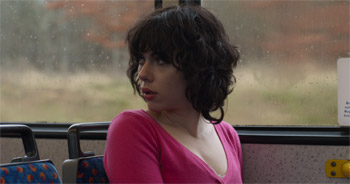 In these moments, the girl falls into a strangely suburban domesticity, watching Tommy Cooper on TV, with a man who finds her at a remote bus stop. Says James Wilson, 'I love the scene where they go to a little supermarket and she just walks around the aisles. It's a real shop, and there you have Scarlett Johansson pretending to be an alien, and she's walking past the Hobnobs. It's incredibly British and parochial, and there's something wonderful about that juxtaposition."
In these moments, the girl falls into a strangely suburban domesticity, watching Tommy Cooper on TV, with a man who finds her at a remote bus stop. Says James Wilson, 'I love the scene where they go to a little supermarket and she just walks around the aisles. It's a real shop, and there you have Scarlett Johansson pretending to be an alien, and she's walking past the Hobnobs. It's incredibly British and parochial, and there's something wonderful about that juxtaposition."Although Jonathan Glazer was sorry to see the end of the more spontaneous aspects of the shoot, it was necessary to focus now on the end of the girl's journey.
There were times when I just wanted to stay in that van and shoot the whole film that way. I think I even said to James Wilson one night, -Let's chuck everything away and see where this goes. Let's just keep driving and see where we end up.' But, of course, at some point you've got to meet the script. It has to meet the script. But you don't want to bend reality in order to get there – you want to feel like you're arriving there via that reality."
Aiding the girl on her travels was the score composed specially for the film by Mica Levi, of UK avant-pop band Micachu and the Shapes and produced by music supervisor Pete Raeburn. 'They did a brilliant job," says Jonathan Glazer, 'an amazing job. I told them I didn't want to have electronic instruments. It needed to feel like a kind of inexorable life force that's going forward, like a shark. It needed to say, -This is what I've always been, this is what I always will be; Just a force.' It also needed to give us her motif, so her music became part of her armoury."
Says Levi of her debut composing credit: 'My job was to do the things you can't see – the girl's feelings and experiences of love, fear, hate, confusion and curiosity. I was directed to think about what she was experiencing, and the thematic ideas are all related to her. I tried to connect any different experience she was having to the music. So the cymbals relate to natural aspects – in my mind they relate to the landscape, the physical spaces, and Scarlett is super imposing in these different scenarios, whether it's in a city or in the sea or forest. There's also a kind of Pied Piper music that she seduces these guys with. Musically, it was like a collage. We used a lot of viola and a lot of synthesised midi-strings, so it was really string-heavy – fake or real. There was also some percussion and flute, but mainly strings and percussion."
Levi's score fulfilled Jonathan Glazer's goal of creating a music score that would organically reflect the themes of his film. 'Scores can often feel like they're on top of the movie," he says, 'but for this it had to be in and of the movie. The same was true of the sound design – we didn't want you to notice where the music ended and the sound design began."
Jonathan Glazer credits sound designer Johnnie Burn with adding an auditory level to the girl's sensory experiences. 'Johnnie Burn used all the bits of sound that a sound editor would throw in the bin," he says. 'They'd usually look for the cleanest take. But it wasn't like that at all for us. It was about finding the textures and noises, the variety of sounds that were bombarding her. We needed you to feel that her change, this drift, was happening by osmosis. She was becoming porous, almost, and these sounds were getting into her. We are changed by our experiences, and those experiences define us, so her story needed to be an accelerated version of ours, in that sense."
The Journey's End
By the time the shoot reached the north of Scotland, Scarlett Johansson had become used to Jonathan Glazer's style of direction. 'It's hard to describe what his method is exactly," she says, 'but, to me, it seems he has a process of finding a scene. It may take him a period of time to find the rhythm of it, find the music in the scene, but once he does, he homes in on it, full steam ahead. He can see the shape of the scene as it is forming and he's very specific but, oddly, at the same time quite unspecific. It's a process of finding the material, and it was fascinating to discover the scenes with him. We had an incredibly close relationship – unusually supportive."
Which was just as well, as shooting the climactic scenes would be among the most intense and physically punishing. Says James Wilson: 'It was incredibly arduous, shooting in that forest, particularly during the weather conditions we suffered at the end, which was a combination of heavy snow and gale-force winds. I'm not exaggerating – it was technically a hurricane, the strongest to hit Scotland in 100 years. Do I regret it? No. Because, genuinely, I feel that without that weather, the forest wouldn't have looked the way it did. But it was definitely the most difficult part of the shoot, and we were in that forest for nine or ten days. At one point we had to suspend filming because 100mph winds were making these big pine trees bow and bend like balsa wood. Equipment was being flung over. But while the main crew stopped, Jonathan Glazer went out with a skeleton crew and one of these miniaturised cameras and went storm-chasing. They came back with some incredible footage of the storm and its interaction on the landscape."
He continues, 'There are some really strong shots of the forest being tossed around that we used in the sequence where Scarlett Johansson's character falls asleep. This is another key audiovisual moment, where this character – whom you've never seen sleep – rests, like a human being would. We then dissolve through her these images of trees that Jonathan Glazer shot through the storm. It captures her sense of turmoil and change – the distending of this character."
Despite shooting in such difficult and potentially dangerous conditions, Scarlett Johansson thought the experience to be a necessary one. 'The weather is another character in the film, really," she says. 'The film is not about a midsummer afternoon, it's about a wild transformation, one that's raging. There has to be that feeling of a looming end, an apocalyptic feeling, and the way it's captured on film, I think the audience will be inclined to fall into it. There were definitely a few days in the forest when I think we all thought the world was coming to an end – in fact, it felt like it almost did when everybody abandoned the set. I always thought the forest was trying to vomit us out of it; that's what it felt like, like it was trying to expel us from it."
It is in the forest that the story reaches its poetic climax, with the girl – actually played by a proportionally smaller body double, wearing a layer of prosthetics as a suit – finally discovers who and what she is. 'That was a key line we wrote in the script," says Jonathan Glazer. 'I think it was, -The inside looks at the outside, the outside looks at the inside.' That was the kind of apex. It definitely felt like everything needed to climb to that point. But I didn't want you to think, -Ah, so that's the alien.' I wanted the alien to remain alien. When you see what happens at the end of the film, you're simply looking at another layer, which I think protects its alien-ness. If not, it's no longer alien, is it?"
The revelation of the girl's true nature takes us back to where we started: the inky blackness of the alien world. Says James Wilson, 'It's the blackness at the beginning of the film, in which you see an iris emerge, then a sphere, then that sphere connects with this black matter, and you see that this is the girl's eye. It's the blackness that the men sink into when they go through the portals of the houses, and our idea was always that this blackness – this black matter – is the alien, something utterly inscrutable and outside anything we know, in terms of our understanding of our individuated idea of identity. And that's what's inside this female figure. You're looking at a perfectly realistic, synthetic human form and at the end you see the blackness inside it."
Says James Glazer, whatever the girl is, she 'remains alien, and I think that's the power of it. If you're going to get involved in that stuff, for it to be an alien experience means that it needs to remain alien. You can't suddenly figure it all out – like, -Oh, I get it now – she's got 48 hours to get water for her spaceship, because their planet is running out.' I didn't want any of that. The book had its own version of that, which was terrific, but it wasn't right for this."
In essence, the film is a delirious meeting of two very different worlds: the mundane and the fantastical, both presented with a commitment to their respective realities. Says James Wilson, 'Genuinely, my feeling about the film – being as objective as I can be – is that it is a very distinctive film in the true sense of the word: distinctive in terms of the feeling of the film, the personality of it. The worlds that it moves through, from the intensely naturalistic and almost documentary-like observation of our world to the completely heightened, nightmarish hallucinogenic world of the alien – the butting of these two tectonic plates – that's something I don't feel I've ever seen before."
As for the girl, Jonathan Glazer feels that, although there are certain ambiguities about her life and motivation, there is definitely an emotional payoff to her journey. 'You see a flame ignite and extinguish," he says. 'You see the beginning of something, the burgeoning of something conscious. You see a light. You see a flicker. You see the presence of something beautiful, short-lived. You see her born, you see her live, you see her die. You hate her, love her, miss her. You see it all."
Under The Skin
Release Date: May 29th, 2014
Have You Seen This?
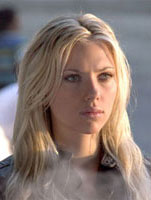
Scarlett Johansson The Island Interview
The beautiful 20-year old Scarlett Johansson runs for her life, as a clone
MORE
- Mission: Impossible Fallout
- Glenn Close The Wife
- Allison Chhorn Stanley's Mouth Interview
- Benicio Del Toro Sicario: Day of the Soldado
- Dame Judi Dench Tea With The Dames
- Sandra Bullock Ocean's 8
- Chris Pratt Jurassic World: Fallen Kingdom
- Claudia Sangiorgi Dalimore and Michelle Grace...
- Rachel McAdams Disobedience Interview
- Sebastián Lelio and Alessandro Nivola...
- Perri Cummings Trench Interview

